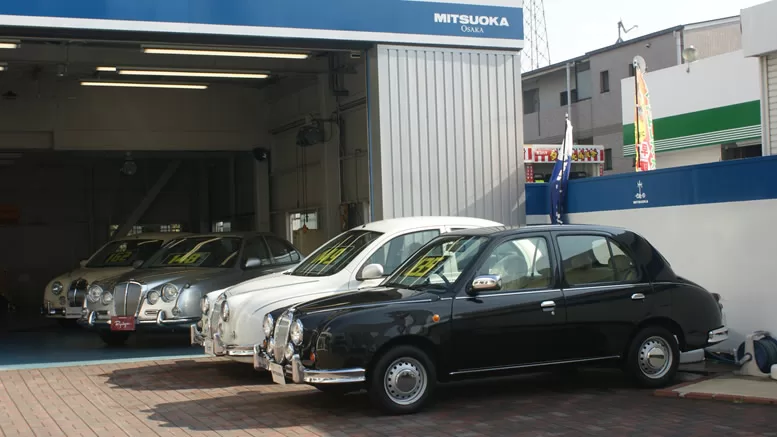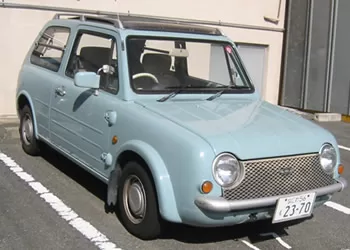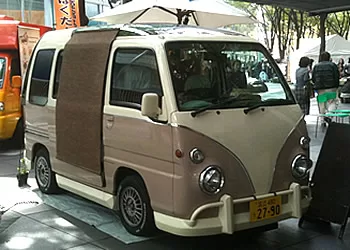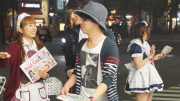Japan’s car scene isn’t just about cutting-edge technology and high-performance machines—it’s also home to some of the most delightfully odd and creatively styled vehicles in the world. From retro revivals by major manufacturers to eccentric custom builds by passionate enthusiasts, Japan’s roads are often rolling showcases of individuality and nostalgia.
Retro Styling – A Blast from the Past
 In the 1990s, Japanese manufacturers dabbled in neo-retro design, creating cars that looked more at home in the 1960s than the modern era. Nissan led the charge with its “Pike” factory cars—limited edition models like the Figaro, Pao, Be-1, and S-Cargo (a quirky van inspired by the Citroën 2CV). These stylish compacts were based on the humble Nissan Micra but wrapped in whimsical, vintage-inspired bodywork that turned heads then—and still do today. Although sold in limited numbers and via a lottery system, these cute retro cars are highly sought after today across the world, where they are often imported by enthusiasts of Japanese kei cars. The S-Cargo is the most popular thanks to its quirky styling—often used by small businesses as an iconic branded delivery vehicle. The Figaro, with its retro convertible looks, is also a favourite as a charming and stylish weekend car.
In the 1990s, Japanese manufacturers dabbled in neo-retro design, creating cars that looked more at home in the 1960s than the modern era. Nissan led the charge with its “Pike” factory cars—limited edition models like the Figaro, Pao, Be-1, and S-Cargo (a quirky van inspired by the Citroën 2CV). These stylish compacts were based on the humble Nissan Micra but wrapped in whimsical, vintage-inspired bodywork that turned heads then—and still do today. Although sold in limited numbers and via a lottery system, these cute retro cars are highly sought after today across the world, where they are often imported by enthusiasts of Japanese kei cars. The S-Cargo is the most popular thanks to its quirky styling—often used by small businesses as an iconic branded delivery vehicle. The Figaro, with its retro convertible looks, is also a favourite as a charming and stylish weekend car.
 Daihatsu got in on the fun too, releasing the Mira Gino, a small kei car that looked startlingly like a classic Mini, arguably outdoing even BMW’s modern remake in terms of old-school charm. Perhaps most ambitious of all was the Toyota Classic, a limited-run vehicle based on a Hilux truck chassis, styled to resemble Toyota’s very first car from 1936. Beyond the manufacturers, aftermarket specialists also offer retro-styled body kits for minivans, with Volkswagen Kombi-style fronts proving especially popular among family cars and delivery vans. In recent years, styling kits that mimic iconic American and European trucks, such as vintage Fords, Chevrolets, or even Citroën H Vans, have also grown in popularity. These nostalgic makeovers offer owners a way to stand out on the roads while tapping into the charm of bygone automotive eras.
Daihatsu got in on the fun too, releasing the Mira Gino, a small kei car that looked startlingly like a classic Mini, arguably outdoing even BMW’s modern remake in terms of old-school charm. Perhaps most ambitious of all was the Toyota Classic, a limited-run vehicle based on a Hilux truck chassis, styled to resemble Toyota’s very first car from 1936. Beyond the manufacturers, aftermarket specialists also offer retro-styled body kits for minivans, with Volkswagen Kombi-style fronts proving especially popular among family cars and delivery vans. In recent years, styling kits that mimic iconic American and European trucks, such as vintage Fords, Chevrolets, or even Citroën H Vans, have also grown in popularity. These nostalgic makeovers offer owners a way to stand out on the roads while tapping into the charm of bygone automotive eras.
Mitsuoka – The Coachbuilder of the Curious
 No discussion of Japan’s retro car scene is complete without mentioning Mitsuoka. This niche vehicle remanufacturer takes existing models from mainstream brands like Nissan and Mazda and reimagines them with dramatically restyled front and rear ends, often mimicking the look of 1960s British luxury sedans. Think chrome grilles, sweeping fenders, and vintage-style headlamps—all grafted onto the likes of a Mazda MX-5 or a Nissan March. Love it or hate it, Mitsuoka’s work is unmistakably unique.
No discussion of Japan’s retro car scene is complete without mentioning Mitsuoka. This niche vehicle remanufacturer takes existing models from mainstream brands like Nissan and Mazda and reimagines them with dramatically restyled front and rear ends, often mimicking the look of 1960s British luxury sedans. Think chrome grilles, sweeping fenders, and vintage-style headlamps—all grafted onto the likes of a Mazda MX-5 or a Nissan March. Love it or hate it, Mitsuoka’s work is unmistakably unique.
Dekotora – Trucks Turned Artworks
 Dekotora (short for decoration truck) is perhaps the most eye-catching example of Japan’s custom vehicle culture. Originating in the 1970s and inspired by the film series Torakku Yarō (“Truck Guys”), these trucks are transformed into rolling art pieces covered in chrome, neon lights, elaborate paintwork, and massive stainless steel fittings. No two dekotora are alike—some are themed after traditional Japanese folklore, while others resemble sci-fi spaceships on wheels. Inside, you’ll often find velvet upholstery, chandeliers, and elaborate dashboard displays. While originally associated with long-haul drivers and trucking subculture, dekotora have become a passion project for hobbyists and collectors alike, often showcased at special gatherings and parades across Japan.
Dekotora (short for decoration truck) is perhaps the most eye-catching example of Japan’s custom vehicle culture. Originating in the 1970s and inspired by the film series Torakku Yarō (“Truck Guys”), these trucks are transformed into rolling art pieces covered in chrome, neon lights, elaborate paintwork, and massive stainless steel fittings. No two dekotora are alike—some are themed after traditional Japanese folklore, while others resemble sci-fi spaceships on wheels. Inside, you’ll often find velvet upholstery, chandeliers, and elaborate dashboard displays. While originally associated with long-haul drivers and trucking subculture, dekotora have become a passion project for hobbyists and collectors alike, often showcased at special gatherings and parades across Japan.
Bōsōzoku Style – Loud, Proud and Defiant
 Bōsōzoku Style is rooted in Japan’s rebellious motorcycle gangs of the 1980s, but its influence lives on in car customisation. These vehicles are loud, brash, and often bizarre—featuring extended exhaust pipes, exaggerated body kits, wild paint jobs, and aggressive decals. Bōsōzoku cars are as much a statement of defiance and individuality as they are a form of automotive art. Many of the designs draw on manga and anime, giving each car a unique personality. Today, the style has mellowed into a nostalgic subculture who pay tribute to the chaotic flair of the original movement.
Bōsōzoku Style is rooted in Japan’s rebellious motorcycle gangs of the 1980s, but its influence lives on in car customisation. These vehicles are loud, brash, and often bizarre—featuring extended exhaust pipes, exaggerated body kits, wild paint jobs, and aggressive decals. Bōsōzoku cars are as much a statement of defiance and individuality as they are a form of automotive art. Many of the designs draw on manga and anime, giving each car a unique personality. Today, the style has mellowed into a nostalgic subculture who pay tribute to the chaotic flair of the original movement.
Stance and VIP – Low and Luxurious
 The Stance and VIP scenes are all about sleek, slammed looks. Stance cars are known for their aggressively lowered suspensions, stretched tyres, and dramatic negative camber on the wheels. This aesthetic prioritises form over function, with shows dedicated to stance culture popular in Japan. VIP Style (often called “bippu” in Japanese) started with large, luxury sedans from brands like Toyota and Nissan, originally customised by members of the yakuza to blend in while still displaying quiet opulence. These cars feature ultra-low suspension, wide wheels tucked under stretched tyres, and elegantly dark or metallic paint jobs—sometimes with subtle pinstriping or lavish interiors featuring curtains and chandeliers. The look is sleek, intimidating, and refined, blending gangster aesthetics with high-end luxury. Today, VIP style has evolved into a respected niche in Japan’s custom car scene, where restraint, balance, and premium details are key.
The Stance and VIP scenes are all about sleek, slammed looks. Stance cars are known for their aggressively lowered suspensions, stretched tyres, and dramatic negative camber on the wheels. This aesthetic prioritises form over function, with shows dedicated to stance culture popular in Japan. VIP Style (often called “bippu” in Japanese) started with large, luxury sedans from brands like Toyota and Nissan, originally customised by members of the yakuza to blend in while still displaying quiet opulence. These cars feature ultra-low suspension, wide wheels tucked under stretched tyres, and elegantly dark or metallic paint jobs—sometimes with subtle pinstriping or lavish interiors featuring curtains and chandeliers. The look is sleek, intimidating, and refined, blending gangster aesthetics with high-end luxury. Today, VIP style has evolved into a respected niche in Japan’s custom car scene, where restraint, balance, and premium details are key.
Whether it’s a tiny kei car made to look like it drove straight out of a 1950s postcard or a glowing chrome-covered truck that could pass for a mobile nightclub, Japan’s car culture offers a fascinating window into the country’s flair for eccentricity, nostalgia, and meticulous craftsmanship. Bring a camera—you won’t want to forget these four-wheeled oddities.




